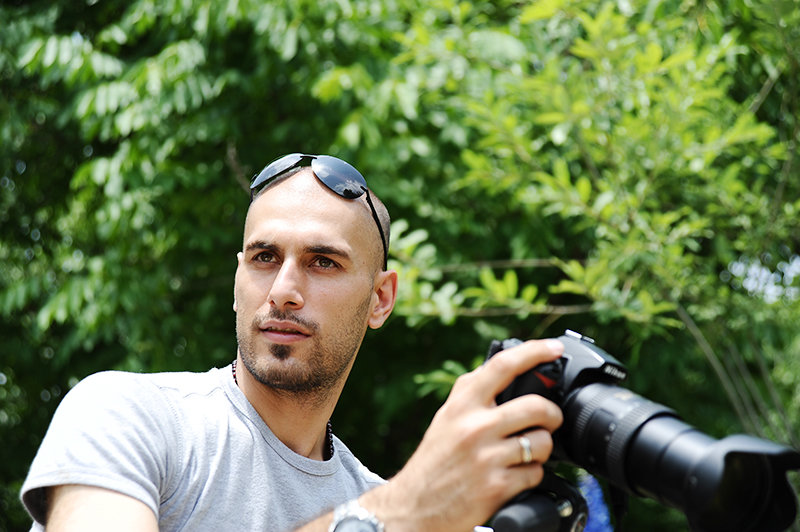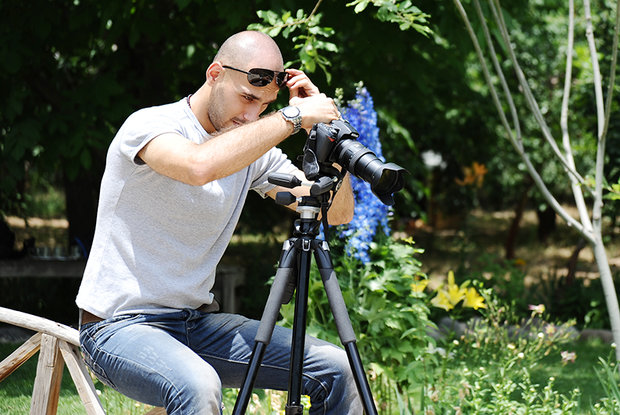Sense of mission leads young artist in way to promote Persian literature

Young calligrapher Amir Jalilvand, who is also a prominent photographer, talks about a sense of responsibility that leads him in a way to promote contemporary Persian literature in Iran today.
TEHRAN – Young calligrapher Amir Jalilvand, who is also a prominent photographer, talks about a sense of responsibility that leads him in a way to promote contemporary Persian literature in Iran today.
He believes that Iranians, many of whom nowadays have an academic education, are suffering from a dearth of minimum knowledge of their literature.
The sense pushed him to use his art in this way. The outcome was “The Spring of Morning”, a collection of works by contemporary poet Mohammad-Ali Bahmani, which was inscribed by a group of prominent calligraphers, including Gholam-Hossein Amirkhani and Abbas Akhavein.
The book, which also contains Jalilvand’s photos of Bahmani and the master calligraphers, was unveiled at Tehran’s Niavaran Cultural Center in April during a ceremony in which the 74-year-old poet and songwriter was honored for his lifetime achievements.
“There are close links between calligraphy and literature, in particular, poetry,” 32-year-old Jalilvand said in a recent interview with the Tehran Times.
“Many masters of Persian calligraphy have repeatedly inscribed the Divan of Hafez, the Rubaiyat of Omar Khayyam, the Shahnameh and works of other luminaries in classical Persian literature, but no work by a contemporary writer had been calligraphed before ‘The Spring of Morning’ was published,” he added.
Commemorating living writers and poets by publishing their works in books inscribed by prominent calligraphers can be inspiring for them, he noted.
The poems for “The Spring of Morning” were selected from the oeuvre of Bahmani by Jalilvand. Forty-three of his colleagues at the Iran Calligraphers Association collaborated with him in the project. However, many others declined participation.
“I engaged in self-sacrifice to get the book published,” Jalilvand mentioned.

Calligrapher/photographer Amir Jalilvand
Jalilvand referred Amirkhani as “the sage of the country’s calligraphers” and said, “In a comment made about the book, master Amirkhani said that a task that seemed to be a pipe dream at the association for years was completed by a young artist.”
However, Jalilvand believes that the book could be much better from what it is if he had the support of cultural organizations.
He is currently working on a new project that will focus on works of Qeisar Aminpur (1959-2007), the most influential poet of post-revolution literature.
The idea of selecting Aminpur for the new project comes from the book launching ceremony.
“When I was presented with flowers and gifts alike at the ceremony, a lifelong friend gave me something wrapped in paper and said, ‘I hope it will be your next project.’ It was a divan of Qeisar Aminpur,” Jalilvand said.
“At that moment, I made my decision without hesitation,” he added.
“Qeisar poetry is very close to his impeccable character; whatever he said was fair and an honorable. As a result, he was the most popular poet of the post-revolution literature,” he stated.
Qeisar’s work about martyrs is scheduled to be the opening poem of the new book. In addition, a poem on veterans injured during the 1980-1988 Iraq-Iraq war has been selected for the collection, which will be inscribed by calligrapher Seyyed Mohammad Sarhaddi, a veteran who is still suffering serious injuries from the war.
“Commemorating martyrs at the beginning, I think will help the book be more impressive,” said Jalilvand who deems himself a patriot.
The book will probably be entitled “The Adze of Imagination”, but Jalilvand is still not certain about the title.
The calligraphy of the selected poems will be adorned with illuminations by masters of this Persian art. In addition, plans are to have English translations of the poems in the book.
However, Jalilvand faces a problem to find an organization to finance the project. He has called cultural and economic organizations in the country and abroad to sponsor the project, which he believes will undoubtedly be a moneymaker.
He repeatedly asked some Iranian cultural centers and galleries to help him organize an exhibition for the collection that he accumulated for “The Spring of Morning”.
He said that the collection includes some works that can viewed as museum pieces, but the centers and galleries have not shown a willingness to provide support.
By such projects, he said that he tries to take a step, even if it is a short one, in familiarizing people about Persian literature and art luminaries.
Jalilvand is also a teacher of art at Tehran’s Pand Primary School, where he helps children in the proper way to read Persian poetry.
“Working with children is great and I try to elevate their knowledge of art and Persian poetry as well,” he stated.
He also holds periodic workshops for people from every walk of life, but people’s ignorance of Persian literature and their luminaries is disappointing for him.
“A Ph.D. student who attended one my workshops didn’t know [poet Mohammadreza] Shafi-Kadkani. It is like this a Frenchman does not know Albert Camus or Jean-Paul Sartre,” he lamented.
Jalilvand also criticized a long interruption to introduce contemporary Persian literature to the world, which he says is unaware of the many amazing works that have been created in contemporary Persian literature.
He says that this ignorance has resulted in the fact that modern Persian literature is not recognized in the international arena while he believes many contemporary Persian authors deserve a Nobel prize.
MMS/YAW
